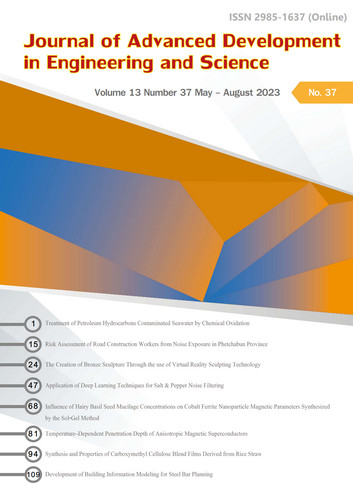Application of Deep Learning Techniques for Salt & Pepper Noise Filtering
Main Article Content
Abstract
This research presents a method for eliminating salt and pepper noise using a deep learning system. The method consists of two steps. In the first step, deep learning systems are trained to identify the noise densities. The second step involves improving the AWMF method (Adaptive Weighted Median Filter) to remove the noise. The deep learning system is adapted to define the sub-window size, which is used in the restoring process. The experimental results demonstrate that the improved AWMF method outperforms the state-of-the-art method at high noise densities and requires less processing time.
Article Details

This work is licensed under a Creative Commons Attribution-NonCommercial-NoDerivatives 4.0 International License.
The content and information in articles published in the Journal of Advanced Development in Engineering and Science are the opinions and responsibility of the article's author. The journal editors do not need to agree or share any responsibility.
Articles, information, content, etc. that are published in the Journal of Advanced Development in Engineering and Science are copyrighted by the Journal of Advanced Development in Engineering and Science. If any person or organization wishes to publish all or any part of it or to do anything. Only prior written permission from the Journal of Advanced Development in Engineering and Science is required.
References
Gonzalez, R. C., & Woods, R. E. (2018). Digital Image Processing. 4th ed. New York: Pearson.
Pitas, I., & Venetsanopoulos, A. N. (1990). Median Filters. Nonlinear Digital Filters: Principles and Applications. Boston, MA: Springer.
Hwang, H., & Haddad, R. A. (1995). Adaptive median filters: new algorithms and results. IEEE Transactions on Image Processing, 4(4), 499–502.
Esakkirajan, S., et al. (2011). Removal of high density salt and pepper noise through modified decision based unsymmetric trimmed median filter. IEEE Signal processing letters, 18(5), 287–290.
Erkan, U. & Gökrem, L. (2018). A new method based on pixel density in salt and pepper noise removal. Turkish Journal of Electrical Engineering and Computer Sciences, 26(1), 162-171.
Zhang, P. & Li, F. (2014). A New Adaptive Weighted Mean Filter for Removing Salt-and-Pepper Noise. IEEE Signal Processing Letters, 21(10), 1280–1283.
Goodfellow, I., et al. (2016). Deep learning. Cambridge, MA: MIT press.
O’Shea, K., & Nash, R. (2015). An Introduction to Convolutional Neural Networks. arXiv:1511.08458v2.
Girshick, R., et al. (2014). Rich Feature Hierarchies for Accurate Object Detection and Semantic Segmentation. In 2014 IEEE Conference on Computer Vision and Pattern Recognition (p. 580-587). 23 - 28 June, 2014, Columbus, OH, USA.
Girshick, R. (2015). Fast R-CNN. arXiv:1504.08083v2.
Bochkovskiy, A., et al. (2020). YOLOv4: Optimal Speed and Accuracy of Object Detection. arXiv:2004.10934v1.
Redmon, J., et al. (2015). You Only Look Once: Unified, Real-Time Object Detection. arXiv:1506.02640v5.
Arunsiriwattana, P., et al. (2022). Laser pointer control for deep learning human detection. Journal of Science and Technology Mahasarakham University, 41(3), 152–163. (in Thai)
Petagon, R. & Pantho, O. (2020). Drone for Detecting Forest Fires using Deep Learning Technique. Sripatum Review of Science and Technology, 12, 66–78. (in Thai)
Tzutalin. (2015). LabelImg. Available from https://github.com/tzutalin/labelImg. Accessed date: 18 April 2023.
Huynh-Thu, Q. & Ghanbari, M. (2008). Scope of validity of PSNR in image/video quality assessment. Electronics letters, 44(13), 800–801.

